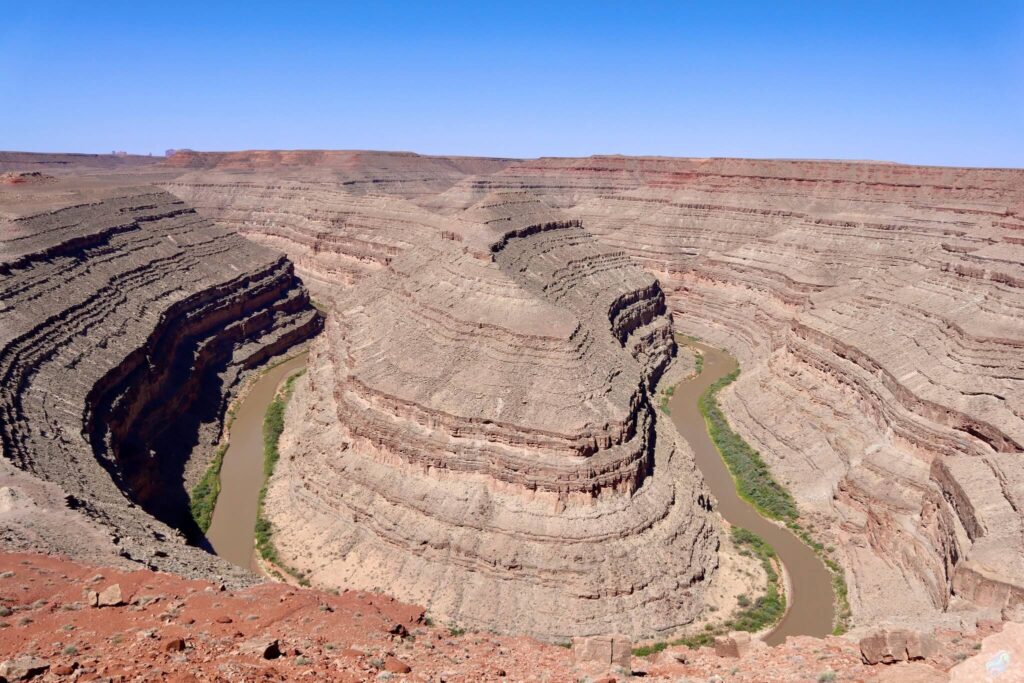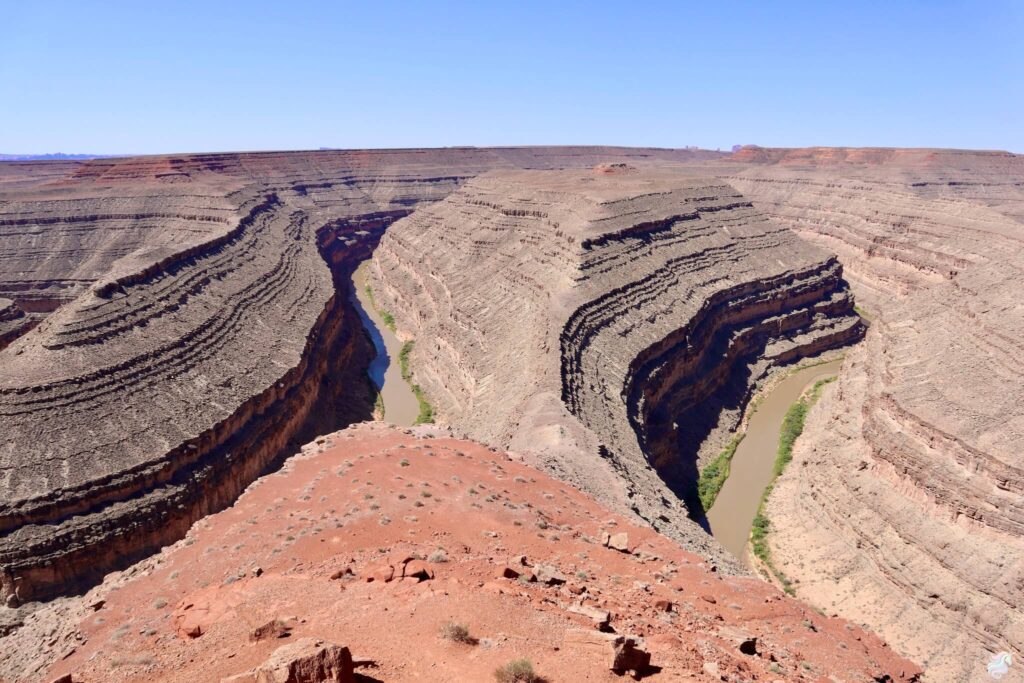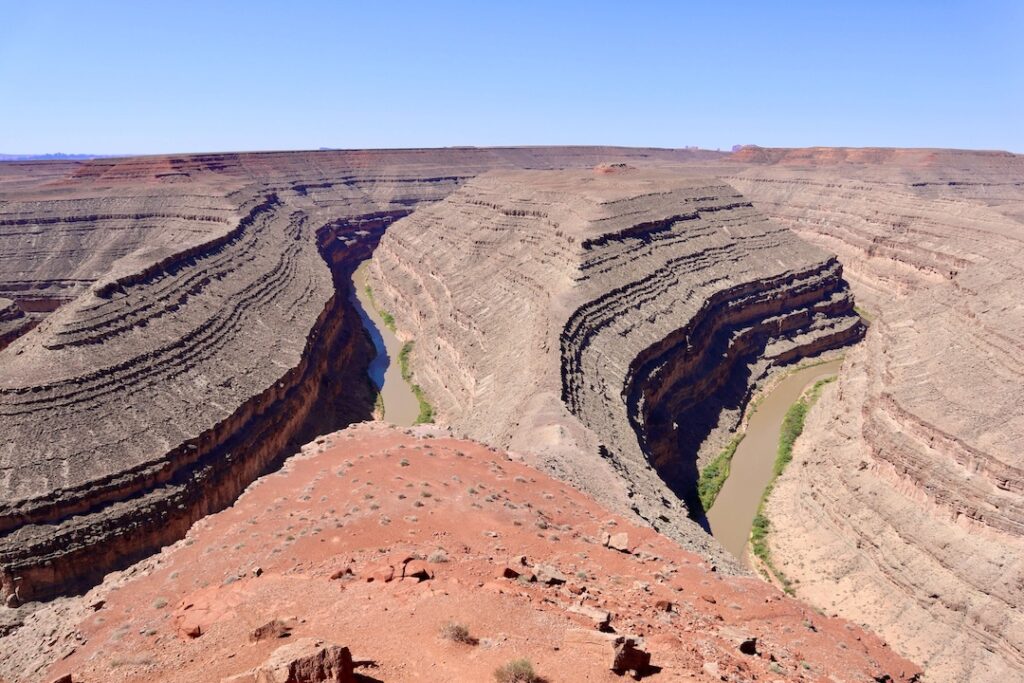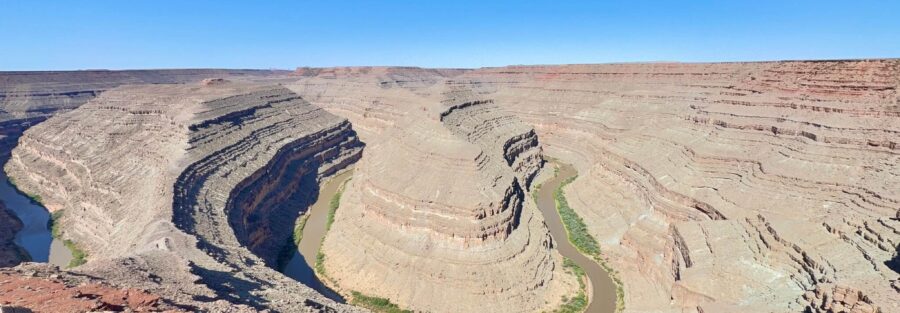Quick Facts:
Location: Goosenecks State Park, Mexican Hat, Utah
Coordinates: 38.29895846464803, -111.2977298713722
Length: Viewpoint
Difficulty: Easy
Elevation Gain: None
Dog Friendly: Yes
Introduction:
Goosenecks State Park is one of those places that makes you stop and say, “Wow!” This small but stunning park near Mexican Hat, Utah, is home to one of the most incredible river bends in the world. The Goosenecks Viewpoint Trail is a short, easy walk that takes you to the edge of a 1,000-foot-deep canyon carved by the San Juan River over millions of years. If you’re in the area, this quick hike is a must-do for photographers, nature lovers, and anyone who wants to witness a truly breathtaking view.
Getting to Goosenecks Viewpoint:
Goosenecks State Park is located about 10 miles north of Mexican Hat, Utah. From Mexican Hat, take US-163 north for about 4 miles, then turn left onto UT-261. Follow UT-261 for approximately 3 miles, then turn left onto Goosenecks State Park Road. The road is paved and well-maintained, making it accessible for all vehicles, including RVs and trailers.
The drive from Mexican Hat takes about 20 minutes, while the drive from Bluff, Utah, takes around 40 minutes. The entrance fee to the park is $5 per vehicle, payable at the fee station at the entrance.

Parking Information:
Parking at Goosenecks State Park is easy and convenient. The main lot is located right next to the viewpoint, with enough space for cars, RVs, and trailers. There are picnic tables and shaded pavilions nearby, making it a great spot for a quick lunch or a scenic break.
Restrooms are available near the parking area. The parking lot provides easy access to the viewpoint and trail, so you won’t have to go far to enjoy the view.
Landscape Description:
The Goosenecks Viewpoint Trail showcases some of the most dramatic scenery in the Southwest. The San Juan River snakes through the canyon below, creating a series of tight, winding loops that look like a giant serpent from above. The canyon walls rise nearly 1,000 feet, exposing layers of ancient rock that tell a story of geological forces at work for millions of years.
The landscape is stark and rugged, with sparse vegetation and endless vistas stretching across the desert. The exposed rock formations are layered in shades of red, orange, and tan, creating a mesmerizing contrast against the blue sky. The river below twists and turns in a series of tight, hairpin bends, making for jaw-dropping photo opportunities at every angle.
The best views are at the edge of the main viewpoint, where you can look straight down into the canyon and watch the river wind its way through the steep cliffs. Sunrise and sunset are particularly spectacular, as the changing light casts dramatic shadows across the canyon walls, bringing out rich, warm colors in the rocks.
Trail Difficulty and Length:
The Goosenecks Viewpoint Trail is more of a leisurely stroll than a strenuous hike. The trail is less than a quarter-mile long and is mostly flat and easy to navigate. It’s a well-defined path that leads from the parking area to the main viewpoint, making it accessible for all ages and fitness levels.
The trail surface is sandy and slightly uneven in places, so sturdy shoes are recommended. The path is not paved, but it is relatively smooth and wide, making it easy for families and casual hikers to enjoy.

Dog-Friendly?
Yes, Goosenecks Viewpoint Trail is dog-friendly, but pets must be kept on a leash at all times. The area is open desert with little shade, so bring plenty of water for your pup, especially during the hot summer months. Be mindful of the steep drop-offs along the edge of the canyon and keep dogs close to avoid accidents.
Park Rules and Regulations:
Goosenecks State Park is managed by the Utah Division of State Parks and adheres to standard park regulations. Stay on designated paths to protect the fragile desert environment and avoid getting too close to the canyon rim, as the rock can be unstable in places.
Camping is allowed in designated areas only, and fires are permitted in established fire rings. There are no developed hiking trails beyond the main viewpoint, so exploring the canyon floor requires a permit and is best done with a guide.
Drones are prohibited within the park to preserve the natural soundscape and prevent disturbances to wildlife. Practice Leave No Trace principles by packing out all trash and respecting the park’s natural beauty.
Other Hikes Nearby:
If you’re looking for more hiking opportunities, head to Muley Point Overlook, located just a few miles west of Goosenecks State Park. The viewpoint offers sweeping views of Monument Valley, the San Juan River, and the Valley of the Gods.
For a longer, more challenging hike, head to the Under the Natural Bridges Trail. This trail offers dramatic Southwest scenery, leading hikers through White Canyon past three distinct natural bridges, Sipapu, Kachina, and Owachomo, each with unique shapes, cultural history, and breathtaking views.
If you’re interested in ancient ruins and petroglyphs, Butler Wash in Bears Ears National Monument is a short drive from Goosenecks and offers several easy hikes to well-preserved cliff dwellings.
Non-Hiking Attractions Nearby:
After your hike, head to the nearby town of Bluff, where you can explore the historic Bluff Fort, a restored pioneer settlement with log cabins and wagons.
If you’re a fan of western movies, drive down to Monument Valley Navajo Tribal Park, about 30 minutes south of Goosenecks. The park’s iconic red rock formations have appeared in countless films and offer some of the most breathtaking landscapes in the Southwest.

Best Time to Visit:
The best time to visit Goosenecks Viewpoint Trail is in the cooler months of spring and fall, when daytime temperatures are mild, ranging from the 60s to 70s. The summer heat can be intense, with temperatures soaring above 90°F. If you’re visiting in summer, plan your hike for early morning or late afternoon to avoid the midday sun.
Winter can be chilly, but the lack of crowds makes it a peaceful time to visit. Snow is rare but possible, and the park can look otherworldly under a light dusting of snow.
Sunrise and sunset are the prime times to photograph the Goosenecks, as the soft, golden light creates dramatic shadows and highlights the deep curves of the river. If you’re staying overnight, the dark skies in the park make it a perfect spot for stargazing, with clear, unobstructed views of the Milky Way.
Support the Adventure
To make your walls less boring, check out my photography portfolio and bring a piece of the wild and my story into your home.
If you’d like to fuel future adventures, you can donate a coffee on Ko-Fi. Every cup keeps me chasing sunrises and stories.
When you shop using my affiliate links, every click helps support this blog at no extra cost to you. It’s a small way to keep Unicorn Adventure alive and kicking while I keep exploring.
Subscribe to my mailing list for future updates, new stories, and behind-the-scenes adventures.
Stay connected with me on Instagram and Facebook for more photos and daily inspiration.
Thanks for being part of the journey, Unicorn Squadron!


